Frederick W. Kagan , Karolina Hird and Kateryna Stepanenko
The situation in Ukraine still favors Kyiv despite the limited progress made in the counteroffensive so far. Ukrainian forces attempted a limited mechanized penetration of prepared Russian defenses in the south in early to mid-June, but failed to break through the Russian lines. They then switched to slower and more careful operations while disrupting Russian rear areas with long-range precision strikes. Ukraine began the next, reportedly main, phase of its counteroffensive on July 26 with a determined drive to penetrate Russian lines in western Zaporizhia Oblast. It’s far too soon to evaluate the outcome of that effort, which is underway as of the time of this writing, but it is vital to manage expectations. Ukrainian forces are fighting now to break through the first line of long-prepared Russian defenses. Several lines lie behind it, stretching for many miles. Ukrainian progress will very likely alternate periods of notable tactical advances with periods, possibly long periods, of pause and some setbacks. Much as we might hope that the road to the Sea of Azov will simply open for Ukrainian forces the odds are high that fighting will remain hard, casualties high, and frustration will be a constant companion. All of which is normal in war.
But the Ukrainian counteroffensive can succeed in any of several ways. First, the current Ukrainian mechanized breakthrough could succeed, and the Ukrainians could exploit it deeply enough to unhinge part or all of the Russian lines. Second, Russian forces, already suffering serious morale and other systemic problems, could break under the pressure and begin to withdraw in a controlled or uncontrolled fashion. Third, a steady pressure and interdiction campaign supported by major efforts such as the one now underway can generate gaps in the Russian lines that Ukrainian forces can exploit at first locally, but then for deeper penetrations. The first and second possibilities are relatively unlikely but possible.
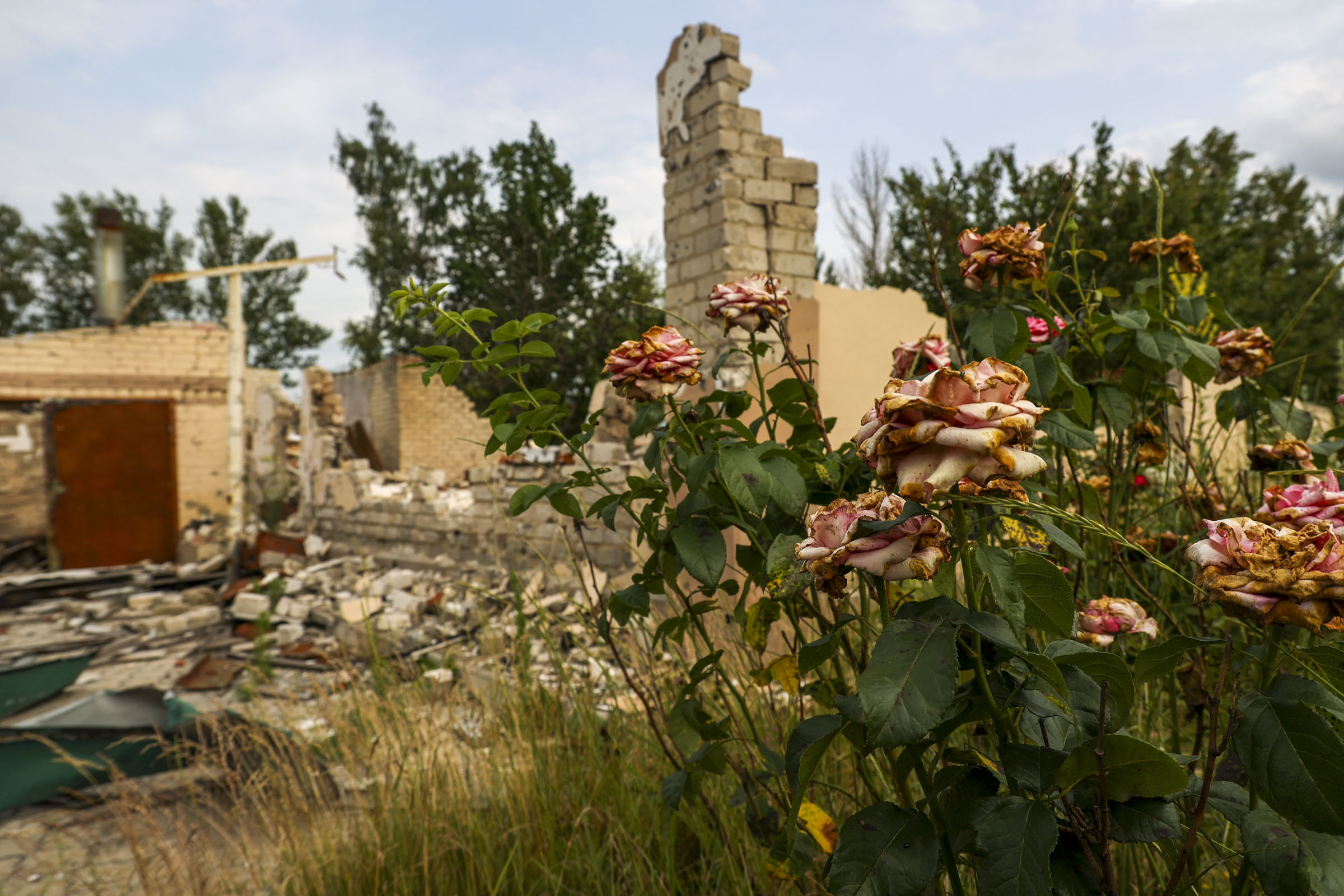
The wooden Orthodox Church of John the Theologian is shown destroyed as a result of shelling by Russian troops in the village of Kuprylivka, Kharkiv region, Ukraine on June 28, 2023.
Sofiia Bobok—Anadolu Agency/Getty Images
The third is the most probable path to Ukrainian success. It will be slower and more gradual than the other two—and slower than Ukraine’s Western backers desire and expect. It depends on the West providing Ukraine with a constant flow of equipment likely over many months so that Ukraine can maintain its pressure until the Russian forces offer the kinds of frontline cracks the Ukrainians can exploit. It is not primarily a matter of attrition. The slow pace of the pressure campaign Ukraine had been using before July 26 is designed to minimize Ukrainian losses. It is not primarily oriented towards attriting Russians either, but rather towards steadily forcing the Russians out of their prepared defensive positions in ways that the Ukrainians can take advantage of to make operationally significant advances. It is still maneuver warfare rather than attritional warfare, just at a slower pace. It therefore requires patience, but it can succeed.
The Ukrainians have been successful with such an approach both in Kherson and in the Kharkiv counteroffensive. The rapid collapse of Russian positions around Kharkiv in October 2022 was the result of months of steady Ukrainian pressure on the ground and in the rear. Ukrainian forces stopped determined Russian advances around Izyum in southeastern Kharkiv Oblast and then launched their own limited counterattacks in mid-September 2022. They targeted Russian logistics hubs and concentration areas behind the front lines for months before launching their decisive effort. That effort caught the Russians by surprise, leading to the sudden collapse of Russian defenses and rapid, dramatic Ukrainian gains. A similar approach in Kherson did not achieve surprise and so did not generate such a large-scale rapid Russian collapse, but it still liberated a large and heavily defended area. A similar approach in southern Ukraine now can offer similar prospects for success.
Ukraine has reportedly committed the main body of the forces it had prepared for counteroffensive operations, although it is not clear what proportion of those forces are actively engaged in combat. Ukraine retains the initiative and benefits from the many advantages discussed below. Its counteroffensive could nevertheless fail. The Russians might prove more resilient than they seem. The Ukrainians might be unable to develop the tactical skills they need to overcome well-prepared Russian defenses. The West might fall short of providing Ukraine the equipment and support it needs in time. The last is the only thing fully under the West’s control. As long as Ukraine still has a serious prospect of liberating strategically vital areas, which it still does, the West’s task is to ensure that Ukraine has what it needs to succeed.
Russia’s Problems
Reasons for confidence in the possibility of significant Ukrainian successes are closely tied to a number of fundamental challenges inherent to the Russian position in Ukraine and the Russian military. These cannot be resolved in 2023, so the opportunities they offer Ukraine are not fleeting. At the strategic level, the geometry of the theater favors Ukraine. At the strategic and operational levels, the lack of Russian reserves forces difficult and complex choices on the Russian military command in the face of Ukrainian counteroffensives. And at the tactical level the way the Russians are conducting defensive operations puts much greater pressure on Russian combat units than the lack of regular or large-scale movements on the map would suggest. All these problems are exacerbated by fundamental flaws in the Russian military itself.
Theater Geometry
The defining characteristic of this phase of the war is that the Russians must defend a ground line of communication (GLOC) consisting of a road and a rail line that runs from Rostov-on-Don at the northeastern edge of the Sea of Azov to Crimea. Vast quantities of food, fuel, ammunition, personnel, and other supplies are required by the tens of thousands of Russian troops in southern Ukraine and must travel along this road and rail line. The Russians were already relying on (and dependent on) this GLOC to supply their troops in southern Ukraine before the most recent break in the Kerch Strait Bridge, because Russian President Vladimir Putin had ordered Russian forces not to rely on the bridge for their logistics after the last major attack on the bridge. The break in that road bridge deprives the Russians of any fallback if the Ukrainians can threaten or cut the Rostov-to-Crimea GLOC.
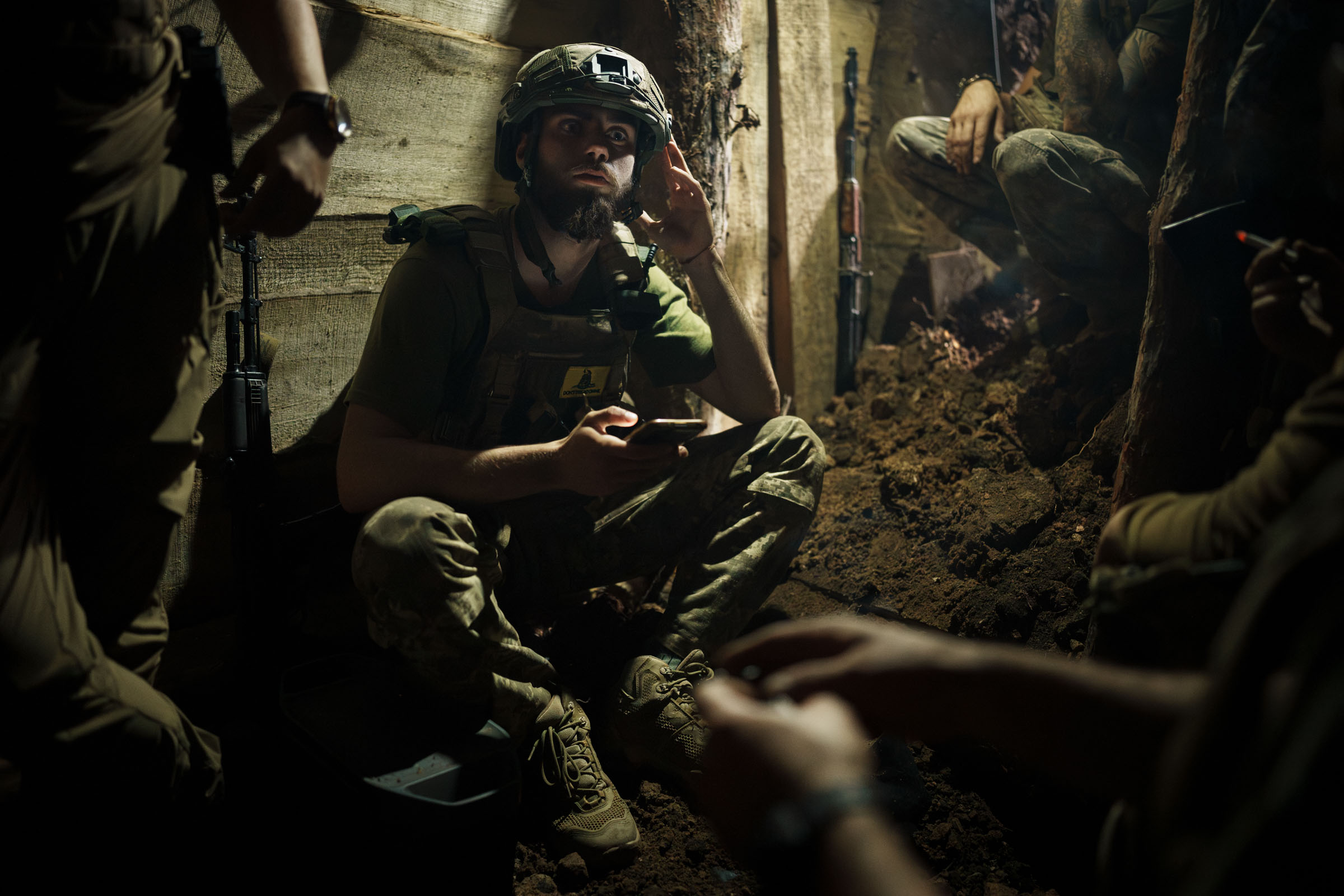
Ukrainian soldiers of 3rd Separate Assault Brigade hide in a dugout during the shelling of Russian tanks and guns on the Bakhmut direction on July 1, 2023 in Donetsk Oblast, Ukraine. Bakhmut and its surroundings continue to be places of most fierce battles since the beginning of the full-scale Russian invasion.
Serhii Mykhalchuk—Global Images Ukraine/Getty Images
This state of affairs favors Ukraine in an important way. If the Ukrainians can reach the Sea of Azov anywhere and hold their positions, they will have cut the GLOC. The Russians, thus, have to hold the entire thing. Put another way, the Ukrainians only have to win and hold in one sector to render virtually all the Russian-held territory west of their advance untenable. The Russians have to win everywhere all the time. The Ukrainians don’t even have to make it all the way to the water. The GLOC does not hug the coast all the way, for one thing, and is thus closer to the current front lines in some areas than the shoreline. If the Ukrainians can push to within artillery range of the GLOC (about 25 kilometers), moreover, they can begin to shell it intensively in a way that would badly degrade the Russians’ ability to continue to use it. The Ukrainians are thus free to choose any sector of the line or take advantage of any hole that opens anywhere in the line, to push to cut the GLOC in a way very likely to collapse the Russian defenses west of that break. The Russians cannot allow any such holes to appear.
Reserves
The Russians suffer from an additional challenge in that they lack operational or strategic reserves. Reserves are uncommitted combat forces able to respond to developing situations in the battlespace. They can be used to take advantage of opportunities such as to break through the lines during an offensive operation or to handle emergencies, for example by rushing in to close a gap in friendly lines before the enemy can exploit it. Reserves are essential in mechanized maneuver war when the combatants can break through each others’ lines and then exploit those breakthroughs to make large-scale and rapid advances. Reserves can play a different role in protracted war, whether attritional or to simply slow maneuver, because the frontline troops in such a conflict become exhausted over time. Reserves can then rotate onto the frontlines to allow the exhausted troops there to move to safer areas in the rear, rest, receive replacements and new equipment, and prepare to take their turns again on the front lines. A military without significant reserves has to require its troops on the frontlines to stay there indefinitely and can temporarily generate the effects of reserves only by pulling forces from one sector of the line to another to deal with unexpected opportunities or reverses. This is exactly the situation the Russians find themselves in now, and the Russian force generation apparatus is currently incapable of bringing up quality reserves to fulfill these roles fast enough.
Lack of dramatic advances or withdrawals does not mean lack of action, still less stalemate. Ukrainian forces continue to press Russian defenders all along the lines with combinations of artillery strikes and ground combat. The Russian defenders are tiring—and complaining about it publicly. It is clear that Russian Armed Forces Chief of Staff Army General Valery Gerasimov, who is also the overall theater commander for Ukraine, has established a policy that seriously limits troop rotations across the theater. One Russian senior commander resigned or was fired over the issue. Russian soldiers or their families periodically release videos complaining about the lack of rotations. Russian milbloggers constantly express concern about the problem. These indicators clearly suggest that Gerasimov’s policy is largely pinning the same Russian forces on active front lines for a long time, forcing them to continue to receive Ukrainian artillery strikes and ground attacks for weeks or months without rest. Since the nature of the Russian defense requires considerable activity of the defenders, as we will consider below, the burden on soldiers required to execute that defense continuously for a long time is wearing.
Gerasimov’s anti-rotations policy is likely based on the reality that Russia simply doesn’t have enough combat forces to hold in uncommitted reserve either to respond to crises or to relieve exhausted front-line troops. Just about all the major Russian ground combat units known to exist in the Russian military have been spotted operating on one sector of the front line or another. A few exceptions appear to be units that were destroyed in Ukrainian counteroffensives and not reconstituted, although it is remotely possible that they are being held in reserve somewhere. That is unlikely, however, judging from the Russian response to Ukrainian advances around Bakhmut. After the Wagner Group forces completed their seizure of almost all of the city of Bakhmut in May 2023 they stopped fighting and then began withdrawing almost immediately. Wagner financier Yevgeny Prigozhin did not coordinate his plans well with the Russian Ministry of Defense (MoD) or Gerasimov, who scrambled to find regular Russian combat units to replace the withdrawing Wagner forces. The Russian forces in the area around Bakhmut thus went from attack to defense without proper preparations. They specifically did not have time to dig good trenches, lay out minefields, and establish other obstacles as their compatriots defending in southern Ukraine did. The Ukrainians took advantage of that situation by rapidly launching counterattacks, particularly on Bakhmut’s northern and southern flanks. Within a few weeks the Ukrainians were making significant gains and looking as if they might make a breakthrough that could force the Russians to abandon their newly captured prize. The Russians clearly needed to send reinforcements to hold Bakhmut and did so, but in a way that made clear that they likely do not have uncommitted reserves. They drew instead on elite forces from the southern Luhansk Oblast sector of the front line, where they had been attempting to press their own attacks and hurled them directly into the defense of key areas around Bakhmut.

A wall of a destroyed hospital remains riddled with shrapnel on June 3, 2023 in Kalynivske Village, Kherson Oblast, Ukraine. Kalynivske is an urban type settlement in Beryslav Raion in Kherson Oblast located on the left bank of Inhulets river. On March 9, 2022 it was occupied by the Russian troops and liberated by Ukrainian Armed Forces on November 9, 2022.
Les Kasyanov—Global Images Ukraine/Getty Images
The Russian command followed a similar pattern in the south. As the Ukrainian counter-offensive in Zaporizhia Oblast began the Russians transferred elements of the 7th airborne (VDV) division that had been holding the Dnipro River line in Kherson Oblast directly to Zaporizhia (taking advantage of the flooding of the Dnipro caused by the Russians’ demolition of the Nova Kakhovka Hydroelectric Power Plant Dam, which temporarily precluded a Ukrainian cross-river assault and reduced Russia’s need for the VDV units to defend that sector of the front line), to the complaints of the division’s personnel.
Lateral transfers of forces from one part of an active line to another are undesirable. They can disrupt offensive or defensive operations in the sectors from which they are drawn and put great pressure on soldiers who must withdraw from combat in one area, move rapidly to another, and immediately launch into new fighting without time to rest men and repair or replace equipment. The fact that the Russian command has generated reinforcements for threatened sectors in this fashion rather than by sending uncommitted reserves, together with the widespread complaints about the lack of rotations of frontline units, strongly suggests that the Russians simply do not have uncommitted operational or strategic reserves.
If the Ukrainians are able to wear through Russian frontline units, let alone if they are able to make a serious penetration somewhere in the Russian line, the Russians will likely be forced to rely on lateral transfers from other parts of the front line to stop them. Executing such maneuvers in the face of an advancing mechanized penetration is extremely difficult. It requires that the Russian command recognize the seriousness of the penetration immediately, pull forces from another point on the line near enough for them to get promptly to the point of penetration, extricate those forces from whatever fighting they were engaged in without opening a different hole for the Ukrainians to exploit, and have them rush right into combat on terms that likely do not favor them. The Russians appear to have managed to accomplish this task twice so far—once around Bakhmut and once in western Zaporizhia—but the odds are that they will ultimately make at least one mistake if the Ukrainians keep presenting them with such crises. The lack of uncommitted Russian reserves, therefore, is another structural factor giving Ukraine an advantage.
Elastic defense
The manner in which Russian forces are slowing the Ukrainian advances especially in the south is doctrinally sound but exhausting for the defender. When the lines on the map do not move very much it may seem that the defenders have it relatively easy—that they are just holding their positions, admittedly under fire, until the attackers tire and pull back. That is not what the Russians are doing, however, for the excellent reason that it would likely fail. Mechanized attacks and even robust infantry attacks can often push through the initial defenses they face—the attackers have the initiative, after all, and attack at times and places of their choosing having prepared themselves for the fight. Defenders have to receive the attacks whenever they come and with whatever the defenders happen to have ready. Trying to stop an attack cold at the first line of defense risks having that line broken in a way that the attackers can exploit for greater gains. Military theory and doctrine thus prescribe an alternative approach similar to the elastic defense that Soviet forces employed in the 1943 Battle of Kursk.
In the current Russian defensive approach a front line of troops most often meets the initial attack but then falls back to prepared defensive positions manned with other Russian troops. The Ukrainians generally advance several hundred meters or up to a kilometer or so, taking losses from mines, artillery, and helicopter and/or drone strikes, and getting tired as they do. When the local Russian commander judges the moment to be right, Russian forces then launch a counterattack to push the Ukrainians back to their original positions, which often succeeds. This approach is generally optimal as it causes the attack to expend much of its power making initial small-scale gains against limited numbers of Russian defenders such that the Russian counter-attacking forces have a relatively easier time pushing them back. Russian forces have in some instances – particularly in early June – repelled Ukrainian attacks without needing to temporarily fall back, most often through the devastating use of anti-tank guided missiles (ATGMs) fired both by ground forces and Russian attack helicopters. However, these Russian successes are the exception rather than the norm, and the Russian defense is based around the use of the elastic defense described above.
The elastic defense is tactically effective, but it puts a significant burden on the defenders. They have to receive the brunt of a prepared Ukrainian attack each time, withdraw in good order in the face of it, and then either motivate themselves or have a second line of forces motivated enough to launch and press a counterattack. The tactical engagement thus ebbs and flows in a very dynamic manner with a lot of moving and fighting that is concealed by the fact that the control lines on the map remain the same at the end of the day as they were at the start.
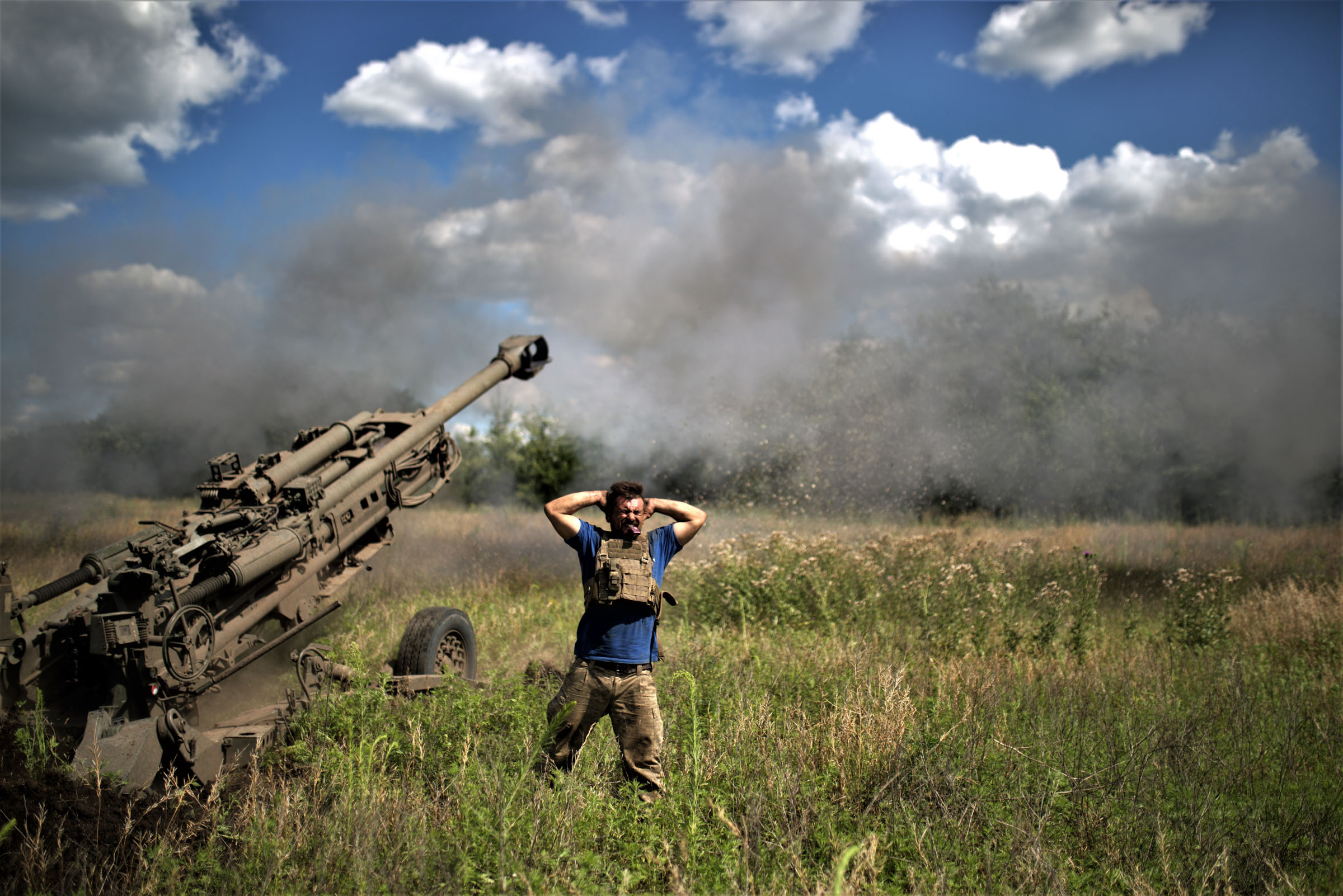
A soldier covers his ears after the firing of an air cannon as Ukrainian artillery division supports soldiers in a counteroffensive on the Zaporizhzhya frontline with M777 in Zaporizhzhya, Ukraine on July 16, 2023.
Gian Marco Benedetto—Anadolu Agency/Getty Images
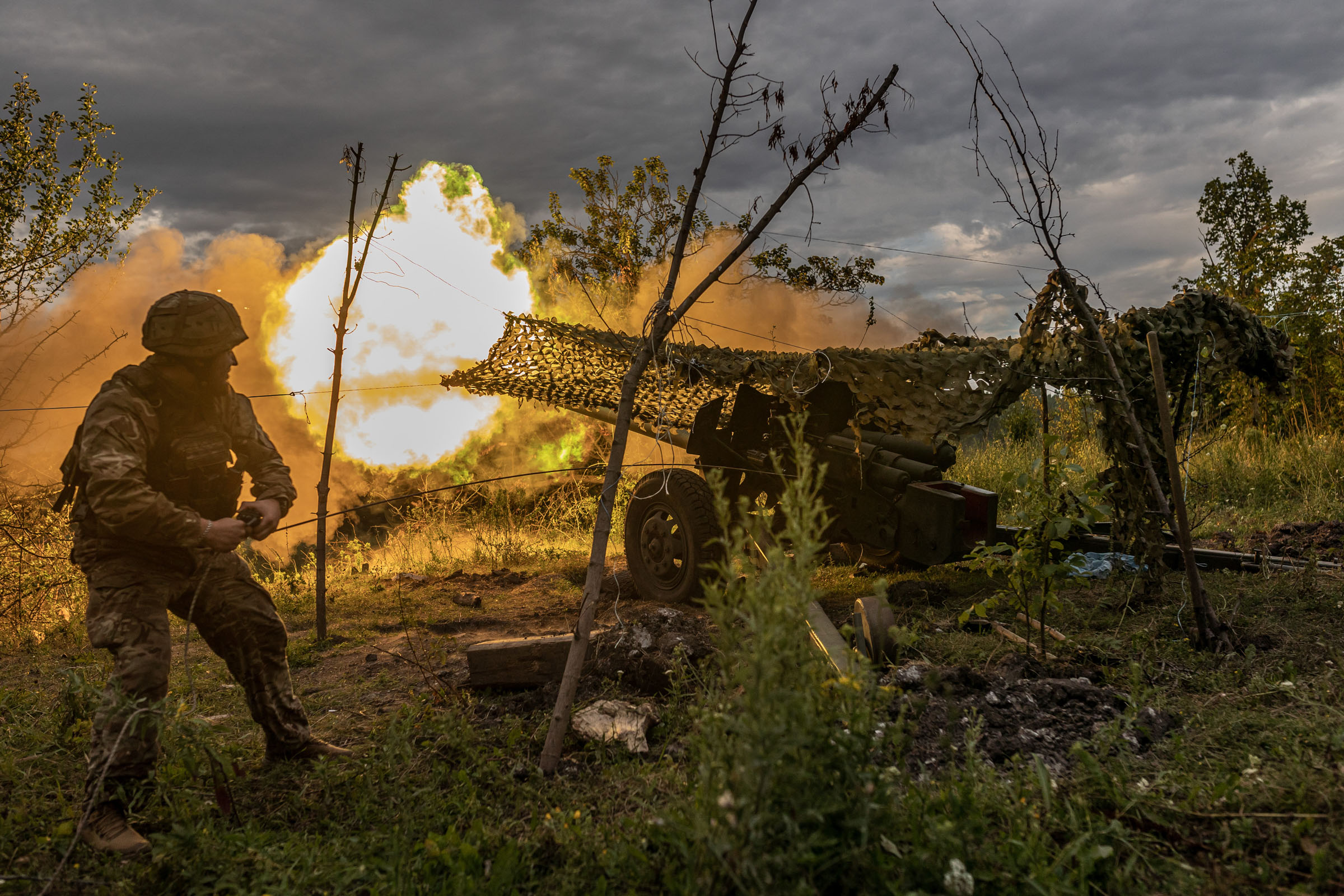
Ukrainian soldier firing artillery in the direction of Bakhmut, Ukraine, July 22, 2023.
Diego Herrera Carcedo—Anadolu Agency/Getty Images
The elastic defense exhausts the attackers, as it is meant to, and inflicts losses on them without allowing them to make permanent gains. But it also takes a heavy toll on the defenders, who must remain motivated and able to continue to launch counterattacks from prepared and defensible positions each time. Exhaustion, losses, and demoralization can all undermine the willingness and ability of defenders to continue launching those counterattacks, especially when the same units and same soldiers have to keep doing it for weeks and months on end without relief, as is the case here because of the current Russian rotational policies. If the Ukrainians can continue pressing the same sectors of the line and the same units, particularly if the Ukrainians themselves can rotate units onto and off the line as it has been reported that they can and do, then the advantages of the elastic defense can fade and ultimately become significant disadvantages. Since each attack starts with Ukrainian gains, if the defenders do not launch their counterattacks or do so only half-heartedly, then each attack will end with Ukrainian gains. This dynamic can thus turn into a Ukrainian advantage over time.
Fundamental problems with the Russian military
Many of the challenges facing the Russians identified above result from structural problems in the Russian military, the Russian defense industrial base, and Putin’s policies that cannot be remedied in any short period. Putin has still not put Russia fully on a war footing—or even admitted that Russia is engaged in a war. Putin and Russian officials still describe their full-scale invasion of Ukraine as a “special military operation.” Putin has not ordered the full mobilization of Russia’s reservists. Russian conscripts are not technically allowed to fight in Ukraine and generally do not. Russia has not maintained a cadre of trainers or the necessary training facilities and equipment to handle a mass mobilization, moreover, and made the further error of sending some of its limited trainers to fight earlier in the war. The Kremlin has turned to an array of irregular forces to make up for Russia’s military manpower deficiencies. The Wagner Group was the most notable such force, but Chechen troops loyal to strongman Ramzan Kadyrov, the militias of the Donetsk and Luhansk People’s Republics (now technically incorporated into the Russian military), Cossack units and other volunteer formations, and a variety of smaller private military companies are all intermingled with Russian conventional forces throughout the theater. This reliance on a multiplicity of different kinds of irregular formations undermines the cohesion and effectiveness of the entire Russian war effort. Russia’s defense industries are also only partially and slowly moving to 24/7 operations, partly because they are suffering from shortages in available trained personnel – in large part exacerbated by Russia’s manpower shortages at the front line, as in some cases the Kremlin must choose between manning frontline units and manning its industrial plants. Russia’s military factories, moreover, have long been inefficient and rife with corruption, problems that the Kremlin and the MoD are struggling to address. Modern Russian military equipment also relies heavily on components that Russia cannot produce domestically, particularly microchips.
These factors and more contribute to Russia’s inability to generate enough trained combat forces—properly equipped to fight modern war - to Ukraine to permit unit rotations, reinforcements, and replacements at the necessary levels. The limitations of Russia’s defense industries have forced Russian troops repeatedly to reduce their rates of artillery fire for lack of ammunition. Russia has reached deep into its stock of ancient tanks, including some dating back to the 1950s, to make up for its inability to produce large numbers of modern tanks, but those old tanks are far more vulnerable to modern anti-tank systems and still require trained crews, which are in short supply. Russian forces have largely used up their arsenal of precision missiles as well, which is one of the reasons for Moscow’s increasing dependence on Iranian drones. Russia’s failure to produce a fifth-generation stealth fighter before the war (or during the war) and continued Russian failures to effectively track and target mobile Ukrainian air defenses has largely kept Russian fixed-wing aircraft out of the skies over unoccupied Ukraine as Western air defense systems began to flow in. Putin might be able to address some of these problems rapidly if he ordered the full mobilization of the Russian Federation, as many Russian ultranationalists demand. But Putin clearly fears the backlash from Russian society and has steadfastly not only refused to issue any such order but also consistently denied the need for it. It is not clear, in any case, that Russian military, economic, and governmental structures are robust and competent enough actually to execute such a mobilization.
We must not overstate the failures and incompetence of the Russian military, however. Russian officers have learned and adapted from their over 500 days of war. Russian attack helicopter pilots, especially in the south, have become extremely skilled and lethal and are the bane of Ukrainian counter-offensive efforts. Russian electronic warfare (EW) capabilities were superb before the war and have only become better, especially in their ability to jam GPS signals on which many precision munitions rely and to interfere with drone operations. Russian troops especially in southern Ukraine, where the Russian military command allowed them to focus on preparing for defensive operations for months rather than insisting on meaningless attacks, have constructed intelligent and deep defensive positions. The execution of the elastic defense described above is another improvement—the Russians have relearned and adapted lessons of conventional wars past and trained their soldiers while in the field to implement them, at least in some areas. And the Russians have repeatedly adapted to Ukraine’s acquisition of longer-range precision weapons (though usually after suffering significant losses) to maintain a rickety and unreliable logistics system that nevertheless generally meets the minimum necessary levels of supply. Involuntarily mobilized reservists now comprise a significant proportion of Russian troops in the theater. They appear to be generally unhappy about fighting, suffer from demoralization, are poorly trained, and frequently complain. But they do fight, on the whole, and sometimes rather well.
These Russian improvements and adaptations have been essential to keeping Russia in the war. They mitigate and work around the fundamental structural problems hobbling Russia’s war effort, but they cannot fix them. They do not offset the advantages Ukraine has that are outlined above.
Ukraine’s Changing Approach
The Ukrainians are also adapting their counteroffensive efforts. They began counteroffensive operations on June 4 and attempted to make several penetrations through prepared Russian defenses in the south using Western-provided equipment. Those counteroffensives were limited in scale, involving a fraction of the brigades the Ukrainians had prepared and equipped especially for the counteroffensive, and limited in duration. They were largely unsuccessful, generating limited gains accompanied by losses that the Ukrainians rightly judged to be unacceptably high. Ukrainian forces had mainly abandoned that approach by mid-to-late June, shifting instead to much smaller attacks conducted primarily by light infantry, often at night and unaccompanied by mechanized vehicles. They have made limited gains in the south using this approach in the ensuing weeks at much lower losses in personnel and equipment before resuming major counteroffensive operations on July 26.
This shift in tactics was part of a larger shift in focus away from seeking a dramatic and rapid mechanized penetration back to the kind of slow and protracted pressure campaign that had succeeded in liberating western Kherson Oblast in November 2022. Ukrainian forces have been attacking Russian supply points, convoys, and headquarters throughout the south for months. They have continued and expanded this campaign in conjunction with the shift to small but constant attacks on the front line with the likely aim of pressuring Russian forces systemically.
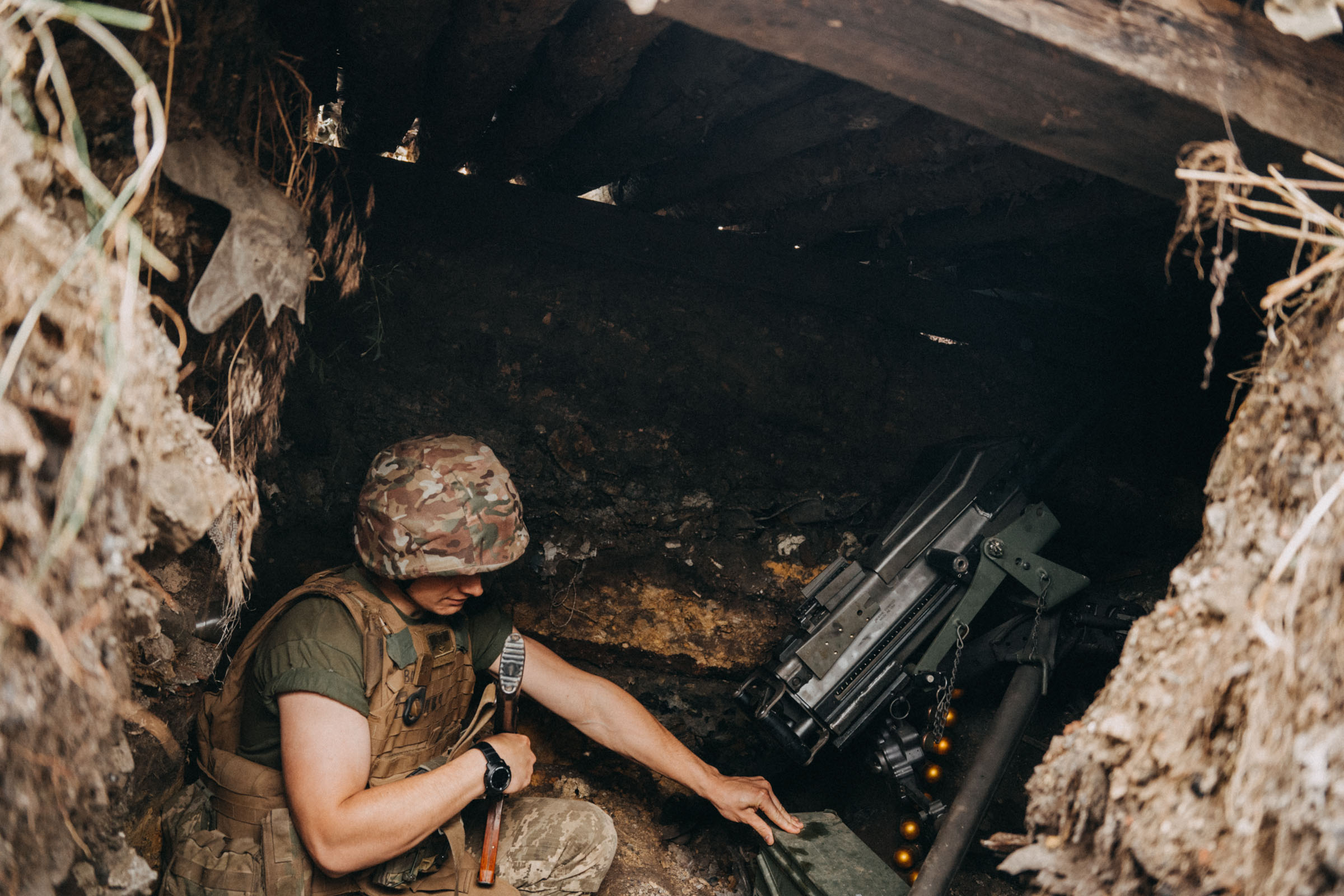
Ukrainian soldiers from the 24th separate mechanized brigade on duty at the frontline near Toretsk in Donetsk, Ukraine on June 27, 2023.
Wojciech Grzedzinski—Anadolu Agency/Getty Images
The complaints from Russian soldiers and the milbloggers who speak for them about conditions on the front lines in the south in the face of even these relatively small-scale Ukrainian attacks suggest that the pressure is having an effect. Russian troops are clearly not finding it a simple task to fend off continuous or nearly continuous limited Ukrainian infantry attacks for the reasons outlined above. The better Russian commanders, some of them likely responsible for the improvement in the performance of Russian troops in the south, have apparently begun to complain to Gerasimov about the inadequate support their troops are getting. Those complaints reached a boiling point when Gerasimov fired Major General Ivan Popov, commander of the 58th Combined Arms Army and the officer responsible for holding western Zaporizhia Oblast, and that commander sent around a scathing audio recording criticizing the Russian high command that made its way rapidly and predictably onto Telegram. Rumors of other commanders complaining and being fired rapidly followed. Those rumors have died down for the moment, and these firings and complaints are unlikely to generate major short-term changes in the Russians’ ability to continue holding their lines, but they serve to show at a minimum the strain Russian forces feel even under the limited front-line pressure they now face.
Ukrainian forces are also clearly working to improve their ability to conduct combined arms operations (by integrating infantry, armor, artillery, and engineering assets—particularly, in this case, mine clearing systems) and appear to be testing small units in combat periodically. They have requested and seem to be receiving additional mine-clearing equipment as well as cluster munitions, which can help them clear trenchlines more rapidly and at lower cost in casualties and equipment.
Ukraine’s struggles to use Western vehicles effectively in mechanized penetration battles are disappointing but should not be too surprising in retrospect. The counteroffensive brigades that received the Western kit were largely new units and lacked the skills that Ukraine’s experienced brigades have developed over many months of combat. The Western equipment itself differs from the Soviet-era vehicles that Ukrainians are used to, and it is understandable that Ukrainian soldiers struggled to use it optimally on their first attempts in combat against a foe that had prepared itself well.
The Ukrainians are learning the ins-and-outs of their new systems, however, and figuring out how to integrate them as the newly formed counteroffensive units get combat experience. Ukrainian performance in the field is therefore likely to improve over time. The Russians, on the other hand, likely generated their peak performance at the start of the counteroffensive. That is when they had been fully prepared, relatively rested, fully supplied, and ready to fight. As the fight goes on and those Russian units are not relieved they are becoming tired, starting to struggle with supplies, and may be becoming demoralized. The Russian performance will thus likely degrade unless the Russians can bring significant reinforcements to bear.
Bakhmut
Ukrainian forces, however, appear to be taking steps to prevent the Russians from reinforcing their lines in the south by attacking the Russian military’s key territorial point—the city of Bakhmut, which Russian forces captured at horrendous cost by May 2023. As discussed above, Russia rushed troops to Bakhmut from other sectors by mid-July, including at least two airborne divisions, one and likely two airborne brigades, at least one Spetsnaz brigade, and several other units. It is unclear if the Ukrainians expected the Russians to send forces from the south to Bakhmut or if they expected the Russians to pull them from Luhansk, as they did. Ukrainian ex post facto statements, however, suggest that they did expect and desire to draw Russian reinforcements to Bakhmut. The result is that, at a minimum, a number of elite Russian airborne and Spetsnaz brigades and regiments are now pinned on Bakhmut and unavailable to relieve the pressure on Russian troops in the south.
Luhansk
The Russians, for their part, are attempting to return the favor by launching offensive operations in Luhansk Oblast likely designed to draw Ukrainian reserves there and away from counteroffensive efforts in the south. This Russian effort has likely been somewhat muted by the diversion of elite troops from southern Luhansk to Bakhmut, but Russian troops further north in Luhansk have continued to advance slowly, putting pressure on Ukrainian troops in the area. Russian gains in Luhansk have been generally less significant than Ukrainian gains around Bakhmut, and the Ukrainians are closer to threatening important lines of communication in Bakhmut than the Russians are to any particularly significant objectives in Luhansk. It is far from clear, therefore, if the Russians will benefit as much from their diversionary efforts in Luhansk as the Ukrainians from their attacks on Bakhmut’s flanks, but it is too soon to tell for sure.
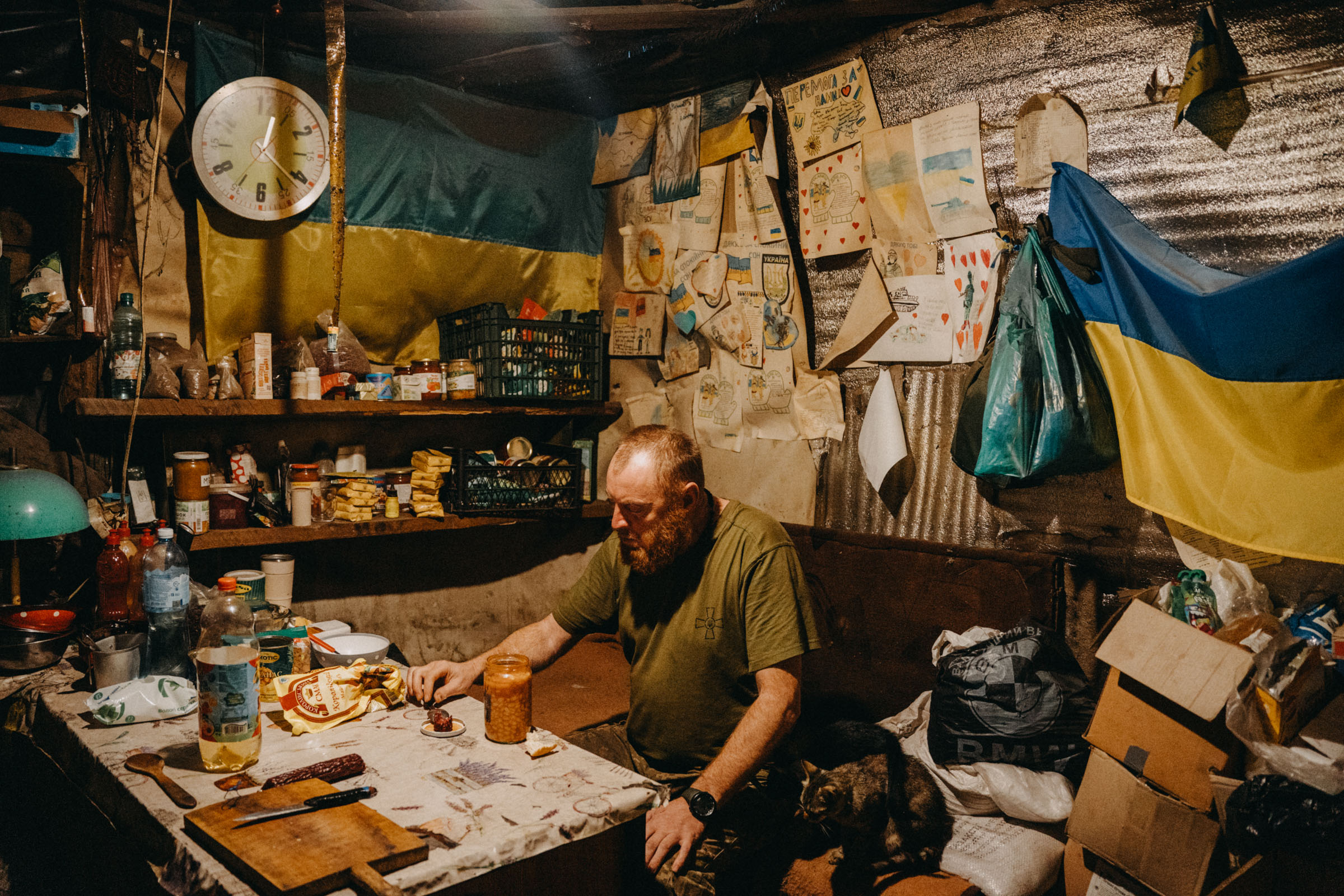
Ukrainian soldier from the 24th separate mechanized brigade eats lunch during his break at the frontline near Toretsk in Donetsk, Ukraine on June 27, 2023.
Wojciech Grzedzinski—Anadolu Agency/Getty Images
The likeliest outcome for now appears to be that both sides will end up fixing in place the forces currently arrayed along the Luhansk-Bakhmut line, making those forces unavailable for redeployment either to conduct or to defend against Ukrainian counter-offensive operations in the south. That situation likely favors Ukraine for the reasons described above. Ukraine has not yet committed the main body of the forces it has available for counter-offensive operations whereas the Russians appear to have all available combat power already on or near the front line.
Lateral reinforcement
The Ukrainians seem, finally, to be working to foreclose the last option the Russians could try to relieve their wearying defenders—shifting forces from a dormant segment of the front line to an active segment. The Russians made a move in this direction early in the counter-offensive, shifting elements of the 7th Airborne Division from near the Dnipro in Kherson to the front line in Zaporizhia—a move enabled in part by the destruction of the Nova Kakhovka Dam and the ensuing flooding. They do not appear to be comfortable moving more forces from Kherson—where there are not too many Russian combat forces to begin with—as Ukrainian troops have reestablished small footholds on the eastern bank of the Dnipro, and the Russians seem to fear a Ukrainian crossing of the river.
The Ukrainians are deterring similar movements of Russian troops from one part of Zaporizhia or western Donetsk Oblasts to another by conducting their limited attacks against most of the Russian units manning the Russian defensive lines. The Ukrainians have not concentrated their attacks on one or two areas—which would have been more normal practice for an intended large-scale and rapid mechanized penetration—but have rather ensured that their attacks affect all three of the Russian combined arms armies (the 58th, 49th, and 29th) and most if not all of the Russian divisions and brigades or regiments subordinated to those armies on the line from the Kakhovka reservoir to near Donetsk City. The continuation of even small-scale attacks against all these units will likely preclude the Russians from pulling any of them out of the line to relieve or reinforce more threatened or exhausted sectors. This pattern of Ukrainian attacks is thus likely an important component of the overall pressure campaign. It should have the effect of preventing Russian forces from moving rapidly to stop the more determined counter-offensive push Ukraine launched on July 26.
Prospects
It is far too soon to tell how the Ukrainian counteroffensive will turn out or especially over what period of time. War is inherently non-linear, and even the most fluid maneuver war alternates periods of rapid advance with periods of relative stasis. The Russians and Ukrainians have been putting great pressures on one another without generating much movement, much as two wrestlers sometimes do before one gains the upper hand and throws the other. The Ukrainians appear to be trying for a throw now, but it is too soon to judge the outcome of this effort which, in itself, is unlikely to lead directly and rapidly to victory.
This situation is not a stalemate, however, and won’t become a stalemate if the current Ukrainian push falls short of expectations or bogs down again after initial successes. Stalemate occurs when neither side can materially change the situation and there is no meaningful prospect that either side will be able to do so in the future. The Ukrainians have not yet demonstrated that they can make rapid and dramatic penetrations at this time, but neither have the Russians shown that they can sustain their current defensive approach against a protracted and probably increasingly effective Ukrainian pressure campaign. The Ukrainians still have the initiative in the theater overall and especially in the south. They choose when, where, and how they will attack. The Russians must defend everywhere and always. The theater geometry may come to play a critical role here as well—the Russians have to win every time; the Ukrainians only have to win once.
The likeliest path to Ukrainian success in this counter-offensive will be slow and staccato. Ukrainian troops continue to press along the front and with attacks against Russian rear areas until front-line Russian defenders lose the will or ability to continue the counter-attacks required by their elastic defense approach. At that point, Ukrainian forces may begin to grind through the Russian defenses 500 or 1,000 meters a day for a time in several locations, creating a series of footholds in the Russian lines until they reach points threatening the Russians’ ability to continue to hold the areas in between these footholds. This pattern shaped the first parts of the Kherson counter-offensive and led to a rather sudden Russian withdrawal from their initial lines to a much smaller pocket. The Ukrainians would likely follow such a limited Russian withdrawal this time by consolidating their gains, resting, and preparing to renew the effort from positions further to the south.
Another possible path, which the Ukrainians are now exploring, relies on more dramatic, large-scale mechanized penetrations of the Russian lines, seeking to unhinge them and facilitate rapid gains for a time. Even successful penetrations and exploitations will culminate, however, before they reach the sea, likely followed by operational pauses.
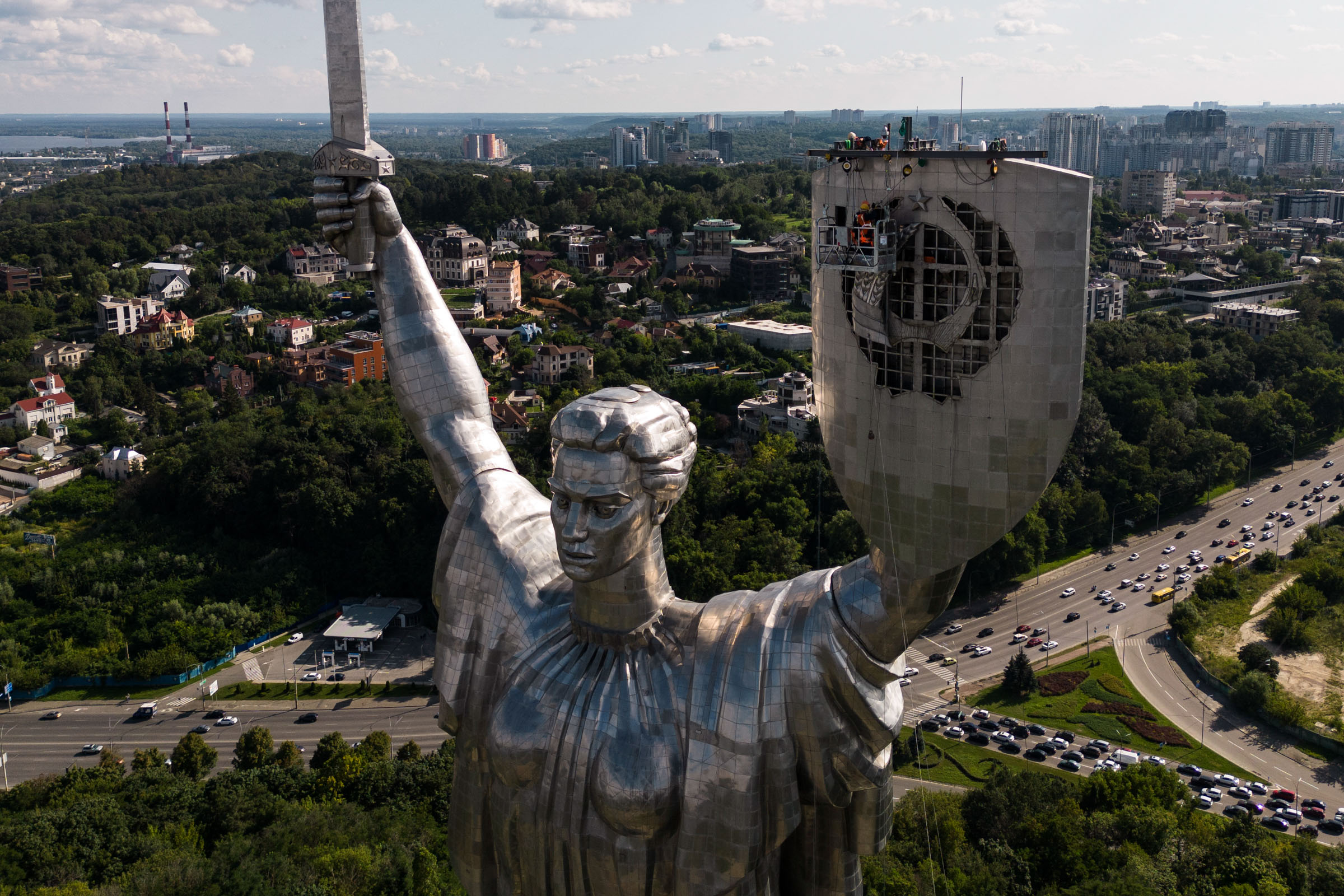
The Motherland Monument is seen after workers removed a Soviet emblem from the shield of the monument in Kyiv, Ukraine, Tuesday, Aug. 1, 2023.
Jae C. Hong—AP
The Russians are likely to begin suffering from several problems in either case. First, the defensive belts they have established full of dense and well-laid minefields do not appear to extend more than 10-15 miles from the front lines in most areas. Unless they are able to establish new lines further to the rear as their defending forces fight and withdraw, they will find themselves at some point having to defend much less well prepared positions. Considering that the forces currently fighting are the ones that dug and prepared the current defenses and that the Russians do not have enough troops to man multiple defensive lines (which we assess to be true because such forces would be suitable for use as reserves, whereas the Russians clearly do not have reserves), it is unlikely that they will be able to replicate their current defensive lines further to the rear. Even if they could, however, the Russians would find themselves with another problem as Ukrainian troops move to within artillery range of critical supply nodes and road junctions. As the Ukrainian advance grinds on, in this scenario, Ukrainian forces will ultimately move to within artillery range of the primary Rostov-to-Crimea GLOCs themselves, which would likely begin to unhinge the Russian defenses along the entire line if they had held thus far.
This entire process would likely take months. The fall muddy season would likely slow it, but probably would not stop it—both sides have continued to fight through Ukraine’s horrible muds. The advance would likely speed up again when the ground hardened and then froze. A campaign of this sort will likely be frustrating. It will alternate periods of relatively rapid but limited Ukrainian gains with long periods of slow, gradual slogging interspersed with pauses in which nothing much seems to be occurring. But as long as Ukrainian forces continue periodically to move forward and the Russians prove unable simply to stop them and hold them, the war will not be stalemated.
Less likely scenarios could lead to more rapid Ukrainian gains. The Ukrainians could figure out how to cohere their various bits of Western and Soviet kit into an effective penetration force and drive through the Russian lines rapidly at one or two locations, unhinging the Russian defenses. It is impossible from outside the Ukrainian military to know if the counteroffensive begun on July 26 is meant to achieve such a large objective, let alone whether it can. It is, however, definitely plausible that the war could take such a turn.
Still another unlikely but possible scenario is that the Russian forces suffer a general collapse under protracted Ukrainian pressure and break in important sections of the line even in the absence of a Ukrainian penetration. Parallel collapses largely removed the French army from active fighting in World War I following the 1917 mutinies and, of course, the Russian army that year as well. It is even more impossible to forecast this sort of contingency, which depends entirely on the prevalent mood and psychology of Russian forces combined with specific events or rumors or events that could trigger such a collapse. What we know of the mood and situation of Russian soldiers, however, suggests that a similar collapse remains possible if unlikely.
Or, of course, the Ukrainian counteroffensive could simply stall out. If it is not clear that the Russians can actually stop the Ukrainians from advancing indefinitely, neither is it certain that the Ukrainians can sustain the pressure long enough to wear the Russians down.
Recommendations
But the Ukrainians can succeed in any of several ways, whereas the Russians must doggedly hold on with almost no real options. Regardless of the outcome of the ongoing effort in Zaporizhia, the situation favors Ukraine.
Ukraine’s backers must avoid rushing to premature conclusions about Ukraine’s prospects. It is far too soon to forecast the outcome of the Ukrainian counteroffensive, and there is no basis for assuming that it will fail. The West must internalize the reality that Ukrainian success is likely to be slower and more costly than many had hoped. It will be punctuated by moments of hope and disappointment. The West must therefore prepare to lean in to providing Ukraine with the materiel it will require for a long campaign and focus on getting it all to Ukraine as rapidly as possible rather than dripping it in gradually over time. Getting Ukraine more mine-clearing equipment is obviously the most urgent requirement. But Ukraine will need a lot more Western armored vehicles including both tanks and armored personnel carriers—since there are no more Soviet-era tanks to be had. Ukraine will also need Western combat aircraft. It is baffling to hear in the West arguments that Ukraine does not need combat aircraft. NATO forces would never undertake to conduct mechanized penetrations of prepared defensive positions without air superiority. The Ukrainians are doing so now because they have no choice, but they are paying a heavy price. They need the ability to keep Russian aircraft out of the skies over the battlefield and to use their own aircraft to assist in their advance.
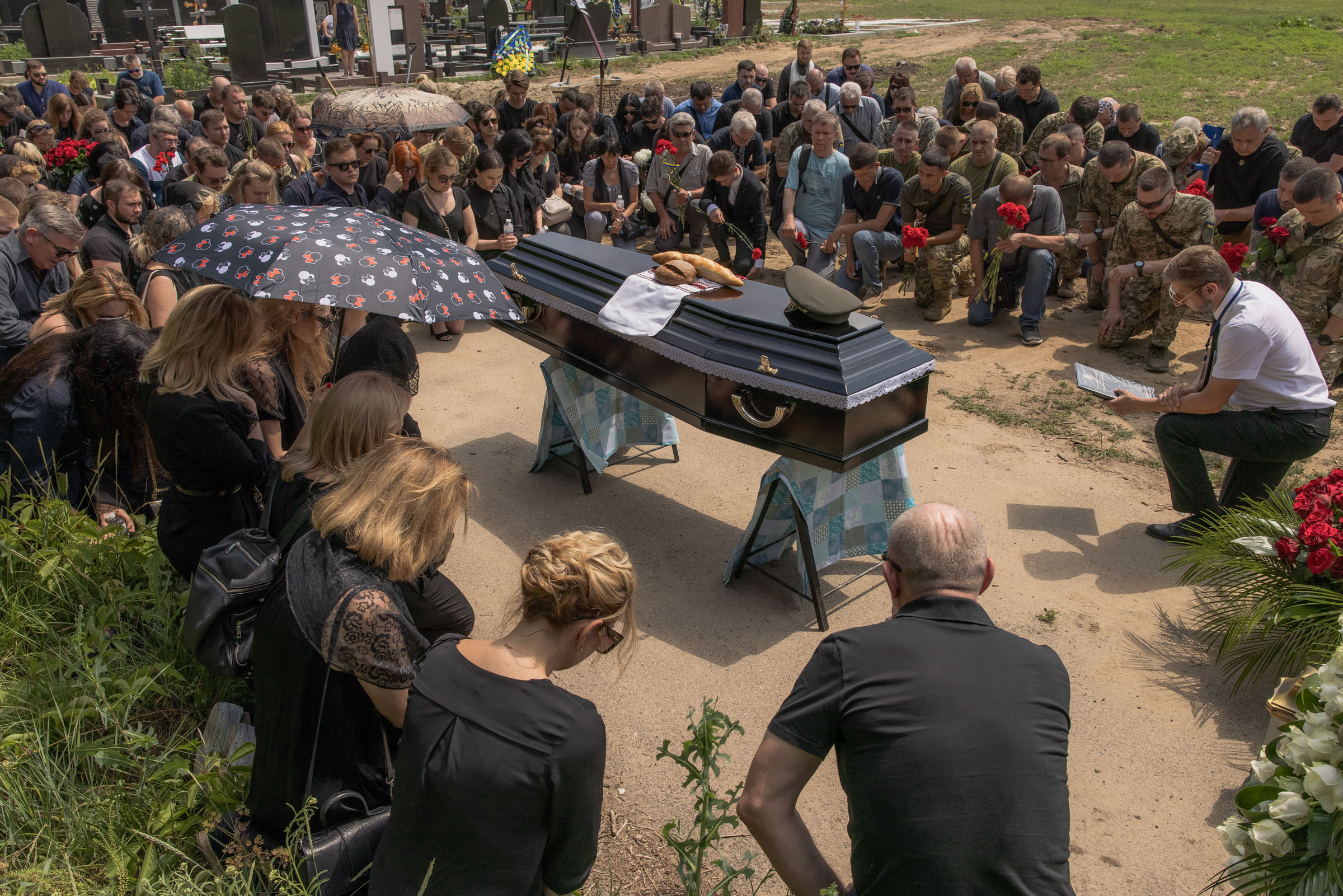
Relatives and friends kneel down next to the coffin of Anton Klitnyi, a Ukrainian serviceman, who was killed fighting Russian troops in the Zaporizhzhia region, during the funeral on July 2, 2023 in Kyiv, Ukraine.
Roman Pilipey—Getty Images
Western support by itself cannot make Ukraine win—but limiting or withholding that support can make Ukraine fail. Ukraine’s Western partners should focus on the variables they can directly affect and avoid falling into the trap of ignoring what they can change in favor of bemoaning what they can’t alter. Ukrainian forces certainly face numerous challenges in the ongoing counteroffensive beyond a lack of equipment the West can provide, and there is no monocausal explanation for Ukraine’s slower-than-hoped-for pace. As laid out above, Russia’s prepared defenses are daunting and the Russian military is degraded but not defeated, and no matter how Ukraine proceeds, its forces face hard fighting against a dangerous enemy. Ukraine’s forces, particularly green and untried counteroffensive brigades, face several challenges that cannot be directly remedied by equipment supplies. Ukrainian forces switched to a slower approach due to the failure of early attempts at large-scale mechanized attacks and heavy initial losses, not because the slower approach is preferable.
Ukraine faces its own manpower challenges after 17 months of war, particularly due to the loss of veteran personnel. Kyiv’s forces are attempting to integrate new personnel, new equipment, and new NATO-taught approaches amidst major operations and are understandably encountering complications. The tendency of some analysts and government officials to focus on Ukrainian challenges to the exclusion of exogenous factors– and at times to argue that Ukrainian forces would succeed with what they have if they only fought how NATO asserts it would fight – is dangerous. Among many other things, the Ukrainians cannot fight the way NATO would actually fight because it lacks so many capabilities that NATO forces would naturally bring to bear, especially airpower and quantities of long-range precision strike.
There is one thing the West must not do. It must not lose sight of the importance of helping Ukraine liberate the strategically vital terrain in the south on which the counteroffensive is now focused. This is not a matter of altruism. Europe and the U.S. need this war to end in a way that reduces as much as possible the likelihood that the Russians will launch a new war of vengeance and conquest some years hence. The positions the Russians now hold in the south are far more advantageous militarily and economically than those they held before the 2022 invasion. They will make the prospect of reversing Russia’s embarrassments through a new invasion far more enticing. They will also badly complicated Ukraine’s efforts to prepare to defend against such an attack. They cripple Ukraine’s economy by severing it from access to international trade through the Black Sea and depriving it of the mineral wealth in the east that had been one of its major economic engines, as well as large areas of agricultural land. It matters to Ukraine and to the West where the lines are drawn when the fighting stops—and both Western and Ukrainian interests are badly harmed by allowing the lines to remain where they are.
We must therefore focus less on how to end this war quickly and more on how to ensure that another war does not soon follow. That means committing to Ukraine’s success in this endeavor and avoiding the temptation to say, “Well, we gave them what they needed to take a shot and they missed. What a shame.” It will be more than a shame if Western support for Ukraine erodes to the point of compelling Kyiv to accept a peace (which Russia is still not offering, it is important to note) on lines that make the renewal of war on unfavorable terms more likely. It will be a major policy failure. It is also unnecessary.
Ukraine is still very much in the game, and the many structural advantages it has offer good reason to expect that Ukrainian forces will liberate vital lands and the people living on them if only the West holds firm in its support.
Kagan is Senior Fellow and Director of the Critical Threats Project at the American Enterprise Institute; Hird is a Russia Analyst and Evans Hanson Fellow at the Institute for the Study of War; Stepanenko is a Russia Analyst at the Institute for the Study of War
No comments:
Post a Comment